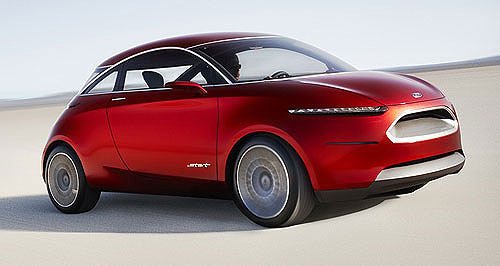Future models - Ford - StartBeijing show: Ford’s urban EcoBoost triple conceptBlue Oval bubble: Ford's Start city car concept debuts Ford's new three-cylinder EcoBoost engine. Ford unveils smooth city car concept with 1.0-litre three-cylinder EcoBoost engine23 Apr 2010 By TERRY MARTIN FORD has unveiled a striking rounded urban-car concept – dubbed the Start – at the Beijing motor show today, complete with a 1.0-litre three-cylinder EcoBoost engine that will soon enter production and is claimed to deliver four-cylinder-like power and hybrid-like emissions. No production timetable has been scheduled for the Start micro, which is a distinct move away from Ford’s kinetic design language and is described as a purer, simpler vehicle that contrasts with the “visual noise” now pervading the market. The Start is not considered a precursor to the next-generation Ka sub-compact, but it does show the direction Ford is taking for future global city cars, particularly for emerging markets. Of more significance is the emergence of the 1.0-litre triple under the Start’s bonnet, the latest instalment of Ford’s EcoBoost direct-injection turbocharged petrol engine range that up until now has been limited to a 1.6-litre four-cylinder, 2.0-litre four-cylinder and a 3.5-litre V6. The 2.0-litre version will be installed in the Australian-built Falcon next year, and comes with claims of delivering “best-in-class fuel economy and V6 performance”.  From top: Ford Start concept, Ford Edge and Ford Focus. From top: Ford Start concept, Ford Edge and Ford Focus.Ford now plans to produce 1.5 million EcoBoost engines globally by 2013, with an EcoBoost version to be available in 80 per cent of the company’s global nameplates – and 90 per cent in North America. While it is still to apply EcoBoost technology to diesel powerplants, the American auto giant also revealed earlier this month that its forthcoming second generation of EcoBoost engines would further connect petrol and diesel engines, broadening the scope from direct injection and turbocharging to new technologies such as exhaust gas recirculation. The latter will help enable higher compression ratios and, together with further refinements (including more advanced forms of turbocharging), Ford expects the engines to yield lower emissions and a further five per cent gain in fuel economy. The company is still to provide specific outputs and detailed technical features of the 1.0-litre EcoBoost unveiled in Beijing today, along with timing and the first model applications, saying only that the engine was “very real and close to being reality”. Less than half the size of the 2.5-litre EcoBoost V6, the compact engine is designed to use a cast iron block, cast aluminium cylinder head and cast aluminium sump. Its compression ratio will be 10:1. According to Ford, the compact architecture makes it ideal for packaging in smaller vehicles. It says “extensive development” shows the still-to-be-divulged power and torque levels are “comparable to a normally aspirated 1.6-litre I4 powerplant” and claims further that CO2 emissions are expected to be under the 100g/km threshold. “Ford engineers have experimented with the idea of a three-cylinder engine for the past 20 years, but felt the power that could be achieved from such an engine configuration couldn't be made substantial enough to offer a practical solution for smaller vehicles,” the company said. “That's all changed with the advanced yet affordable Ford EcoBoost technology, first introduced in 2009 and proving that substantial power and fuel savings can be realised through a combination of turbocharging and direct fuel injection.” In the Start, which is the first “pure concept” Ford has developed under its so-called One Ford integrated global design and platform-sharing ethos, the three-cylinder engine is understood to be paired with a six-speed manual transmission. The Start’s economy and emissions advantages are reinforced by aerodynamic design elements – a full underbody tray, flush upper-body treatments, carefully constructed front fascia, for example – and a host of weight-saving measures employed across the vehicle, including a “hybrid aluminium/high-strength steel body construction”. A lightweight aluminium safety cell is used, while all exterior body panels are made from deformable, pre-coloured recyclable composites. The concept also features pressed-aluminium wheels shod with lightweight, low-rolling-resistance Michelin Green X tyres. Natural sisal fibre is used to form the interior panels. In total, Ford claims its “holistic” design approach – the advanced drivetrain, materials and clever construction – demonstrates that a weight saving of 140kg is possible, even in such a small vehicle. Chief creative officer and group vice-president J Mays said the Start, which was designed at Ford’s Strategic Concepts Group in Irvine, California, is a back-to-basics vehicle pitched at a global audience. He said the design team drew inspiration from an original Porsche 356 Speedster and an Alfa Romeo Zagato SZ, with exterior design elements deliberately kept simple, functional and consistent. "In an era of constant visual noise, we have created a car that conveys visual purity and harmony, in which every line has meaning and purpose,” Mr Mays said. “The Ford Start delivers a dynamic, personality-driven design that stays true to the global Ford brand. "Our vision was to look at a small car holistically, like slicing through an onion where every layer gave meaning, function and substance to the next. As in nature, taking this approach creates beautiful, endearing objects.” The interior is meant to complement the direction of the exterior, with a design that delivers a “pure, tactile and analogue” experience for the occupants. "The cockpit is about being the right size with everything you need in the right place,'' Mr Mays said. “We concentrated on providing only the information the driver really finds necessary. Great visibility was a major priority as well as driver control and passenger safety and space."The cabin also introduces a "MyFord Mobile Concept” which is described as a conceptual look into how to leverage smart phone interface with the popularity of personalised "apps". Also at Beijing, Ford’s next-generation Focus small car and facelifted Edge mid-size crossover made their Asian debuts. Not due on sale in Australia until 2012, the Focus was unveiled at the Detroit motor show in January, with a wagon version following at Geneva in March. The Edge, meanwhile, could form the basis of the next-generation Territory SUV sold in Australia – a prospect that has emerged after Ford Motor Co management confirmed that the next Falcon (and its derivatives, including Territory) will move into line with the One Ford strategy.  |
Click to shareFord modelsResearch Ford Motor industry news |














Facebook Twitter Instagram